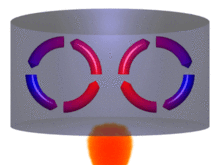Natural convection
With natural or free convection , a fluid flows on the basis of different pressures present in the system , which are caused by a gravitational field if there are areas of different density in the fluid . If it comes to a closed circuit, one speaks of gravity circulation (see chimney effect ).
The opposite of free convection is the convection forced by technical means .
Basics
Permanent circulation always occurs when a heat source is lower than a heat sink ( " cooling " ) because the heated fluid has a lower density (i.e. a lower mass per unit volume) and therefore experiences a static lift in the gravitational field . If heating and cooling are exchanged, circulation comes to a standstill.
In space there is no circulation due to the lack of matter and in a volume of air enclosed inside a satellite due to the weightlessness .
When water is heated from 0 ° C to 4 ° C, the reverse case occurs exceptionally, its density increases and it decreases. This is due to the density anomaly of water, which occurs in the vicinity of 4 ° C and causes a special temperature stratification .
The flow speed depends on the temperature difference and can only ever take place in the direction from "warm" to "cold" for the heated fluid. For technical processes, fans or pumps are therefore often used to control the convection .
Physical background
The difference in density is maintained by heating on one side and cooling on the other side of the circuit. The resulting differential pressure is called “driving pressure” or “effective pressure”. One also speaks of the effect of gravity.
The differential pressure depends on the density difference and the effective height according to the formula:
- : effective height in m
- : Acceleration due to gravity in m / s²
- : Density at temperature 1
- : Density at temperature 2
Examples
building technology
In the building services is the gravity circulation principle, any gravity heating , which, however, was almost completely replaced by the pump heating. This principle is also used in the so-called "bathing line", which runs parallel to the hot water pipe without a pump and provides a warm bathroom all year round.
In thermosiphon systems , the heat is supplied via the solar collector , in which circulation begins with subsequent cooling and / or removal of the water.
In boiler construction , special guide plate constructions lead to the circulation of the boiler water between the boiler wall and the downstream heating surfaces . This achieves a uniform temperature distribution in the boiler material, as a result of which the thermal stresses are reduced.
The gravity circulation as "back circulation" is not desired. This occurs, for example, when, when the pump is at a standstill, the water in the return line presses in the opposite direction on the pump and sets it in motion. This affects pump heating systems and solar circuits. So-called gravity brakes are built to protect the pumps . These are check valves or so-called "disk disks" which - installed in front of or behind the pump - prevent the water from flowing back.
Energy generation
meteorology
Numerous convection processes also take place in the earth's atmosphere . The land-sea wind system is found near the coast . Since the surface of the land mass heats up or cools down faster than that of the water, there are greater diurnal fluctuations in the air temperature over the land, while the sea air remains closer to the daily average. As a result, the air over the land warms up more during the day, which means that the air pressure decreases less with altitude. Therefore, the air flows upwards towards the lake, while the pressure near the land surface is lower than above the water and therefore sea air flows in (A). At night, on the other hand, the air over the land cools down more, which starts the opposite process. The air is concentrated over the land in deeper layers (B), so it has a higher pressure than the sea air at lower altitudes and flows to the water due to the pressure difference.
On the surface of the earth, too, there are different degrees of heating due to the shape of the terrain and different surfaces. Warm air masses separate and rise in the form of thermals . Such air movements can be supported by condensation processes , which heat up the rising air by releasing latent heat and thus accelerate the upward movement.
See also
- Thermophoresis , in which gravity does not play a role
- Jacket convection









